Asking prices remain buoyant with property in short supply across the country
13-year record stock lows nationally and in sixteen regions
Real-time data from realestate.co.nz suggests that stock shortages will continue to pose challenges for Kiwi buyers at the start of 2021.
Housing stock was down year-on-year in almost every region in New Zealand during December, with 16 of 19 regions falling to all-time lows since records began 13 years ago. The national stock level was also at a record low.
Vanessa Taylor, spokesperson for realestate.co.nz, says this is despite a year-on-year 19.2% increase in new listings coming onto the market during December.
“There were 29.1% less homes available for sale at the end of last month compared to December 2019, creating a significant mismatch in supply and demand.”
“We’re still seeing a lot of competition in the market and I expect this will continue to drive strong prices in the first quarter of 2021, encouraged by low mortgage rates and a lack of international travel,” says Vanessa.
The national average asking price is now $799,190 – a 13.6% increase on December last year.
Average asking price up 13.6% on last year, with record highs in two regions
Real-time data from realestate.co.nz shows the national average asking price remained stable month-on-month in December with a marginal 0.3% increase on November 2020. However, this number increased by 13.6% when compared to December 2019.
The asking price for properties around New Zealand was $799,190 at the close of 2020, compared to $703,780 in December 2019.
“Asking prices nationally are now $95,410 more than the same time last year,” says Vanessa.
Two regions reached all-time average asking price highs in December, with Bay of Plenty and Central North Island recording peak prices since realestate.co.nz records began 13 years ago.
Bay of Plenty prices were up 8.1% year-on-year, with the asking price reaching a high of $780,475.
But it was Central North Island that recorded the country’s biggest increase, with the region’s average asking price climbing to $685,044 – up 20.7% on November 2020 and 38.8% on December 2019.
“Although this might be welcome news for sellers, it may not be time to celebrate just yet.”
“We saw a significant number of high-end and large lifestyle properties come onto the market in the Central North Island during December, which has pushed the average asking price up,” cautions Vanessa.
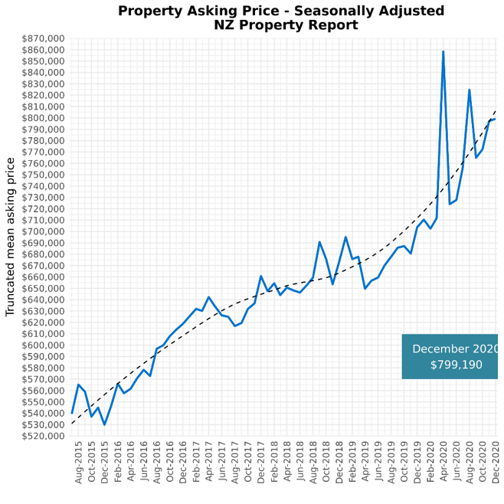
Stock shortage continues, with record lows nationally and in 16 regions
Property remains in short supply across the country with only 12,932 homes available for purchase in New Zealand at the end of December – 29.1% less than the same time last year, a 13-year record low.
Housing stock was down year-on-year in almost every region last month, with 16 of 19 regions falling to record lows.
“Only Auckland, Gisborne and Central Otago/Lakes avoided hitting 13-year record stock lows in December,” says Vanessa.
Wairarapa, Coromandel and Nelson & Bays had the lowest stock compared to 2019, decreasing by 58.5%, 50.3% and 49.2% respectively.
“The stock shortage will likely continue to prove challenging for buyers at the beginning of 2021,” says Vanessa.
“This is a long-term factor impacting the New Zealand market and the number of Kiwis returning from overseas, combined with low mortgage rates and lack of international travel, are only adding to the demand for property.”
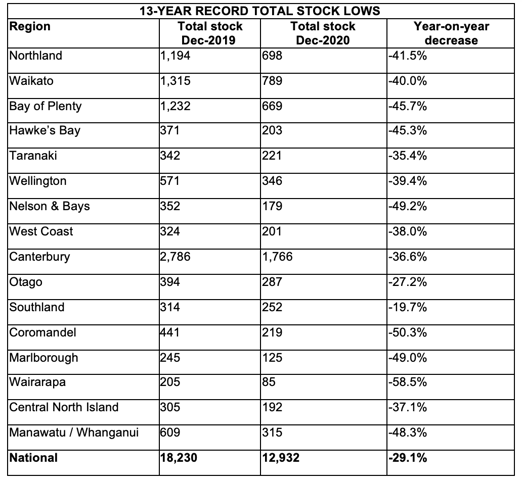
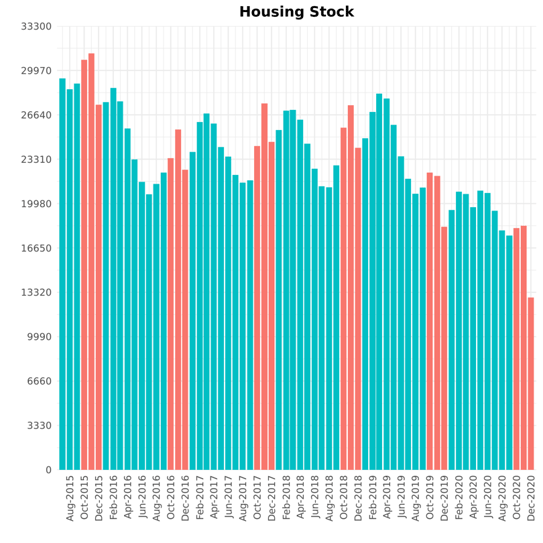
New listings up – but regions still in short supply
New listings are up 19.2% year-on-year to 6,592, with 1,064 more properties coming onto the market last month than December 2019.
“Although it’s promising to see pockets of new listings coming onto the market across the country, it was largely our major centres that did the heavy lifting last month,” says Vanessa.
Of the 6,592 properties that came onto the market in December 2020, more than half were in Auckland, Wellington and Canterbury.
“Buyers in regional New Zealand are still faced with little choice at the moment,” says Vanessa.
Auckland saw the most significant increase in new listings last month, with 52.0% more new listings compared to December 2019, while Marlborough saw the biggest decrease with 23.5% fewer properties coming onto the market.
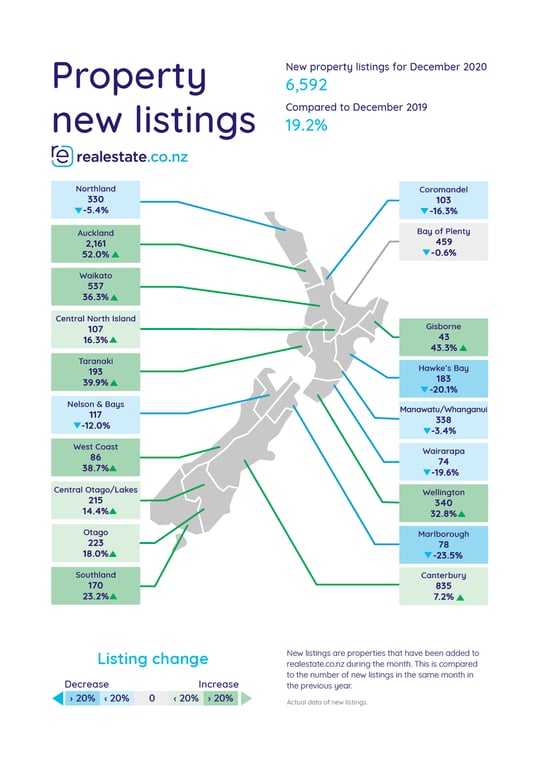
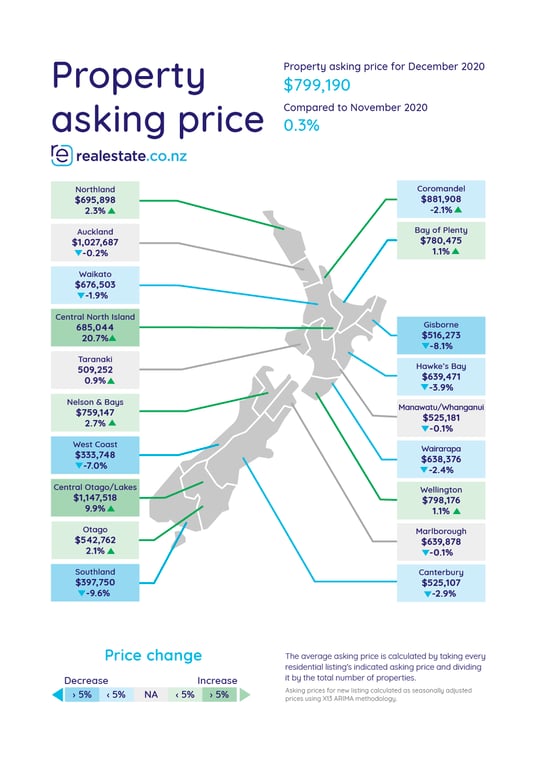
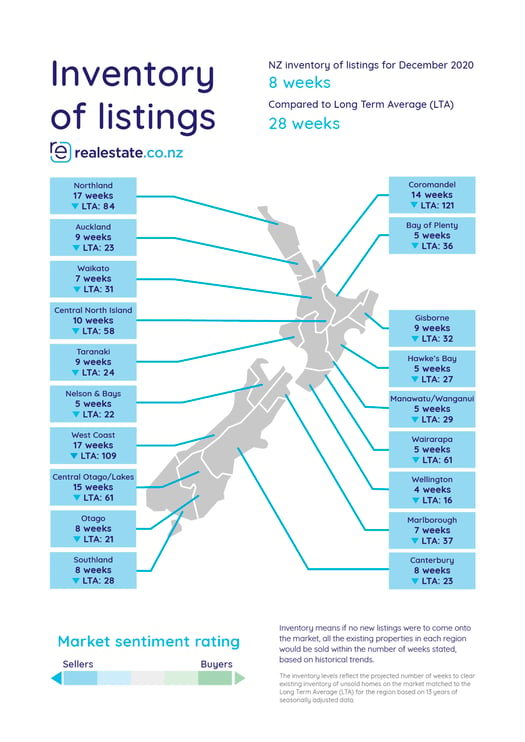
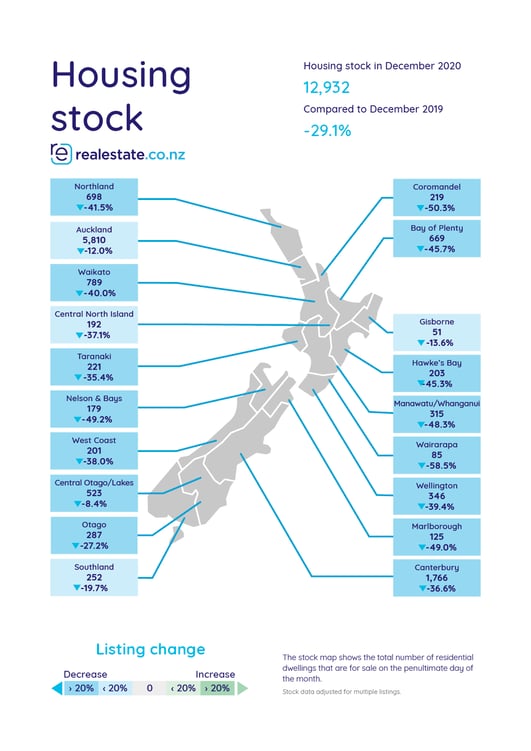
ENDS
For media enquiries, please contact:
Trish Fitzsimons | 021 022 96927 | trish@realestate.co.nz
About realestate.co.nz
Established before Google, in 1996, realestate.co.nz is New Zealand’s longest-standing property site. With residential, lifestyle, rural and commercial property listings available, realestate.co.nz is the place where serious buyers look for property. Dedicated to property, realestate.co.nz has no private sales and has search functionality that’s second to none to get you to your perfect property faster.
Glossary of terms:
As the only provider of real estate data in real-time, realestate.co.nz offers valuable property market information not available from other sources.
• Average asking price is not a valuation. It is an indication of current market sentiment. Statistically, asking prices tend to correlate closely with the sales prices recorded in future months when those properties are sold. As it looks at different data, average asking prices may differ from recorded sales data released at the same time.
• Inventory is a measure of how long it would take, theoretically, to sell the current stock at current average rates of sale if no new properties were to be listed for sale. It provides a measure of the rate of turnover in the market.
• New listings are a record of all the new listings on realestate.co.nz for the relevant calendar month. As realestate.co.nz reflects 97% of all properties listed through registered estate agents in New Zealand, this gives a representative view of the New Zealand property market.
• Demand: the increase or decrease in the number of views per listing in that region, taken over a rolling three-month time frame, compared to the same three-month time frame the previous year – including the current month.
• Seasonal adjustment is a method realestate.co.nz uses to better represent the core underlying trend of the property market in New Zealand. This is done using methodology from the New Zealand Institute of Economic Research.
• Truncated mean is the method realestate.co.nz uses to provide statistically relevant asking prices. The top and bottom 10% of listings in each area are removed before the average is calculated, to prevent exceptional listings from providing false impressions.
07 Jan 2021

